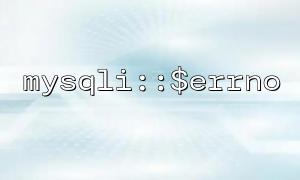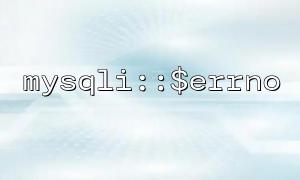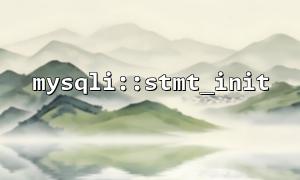When using PHP to manipulate MySQL databases, we often use the mysqli extension to connect to the database. However, during the actual development process, database connection errors occur frequently. In order to facilitate us to detect whether the connection is successful, we can obtain the error code through mysqli::$errno to determine whether there is any problem with the database connection. This article will introduce how to determine whether a MySQLi connection is wrong through mysqli::$errno , and how to process it according to the error code.
When connecting to a database using MySQLi extension, we usually connect through the following code:
$host = 'localhost';
$username = 'root';
$password = '';
$dbname = 'test_db';
$connection = new mysqli($host, $username, $password, $dbname);
However, the connection may fail for a variety of reasons, such as the database service not being started, the username and password are incorrect, etc. To be able to catch these errors and handle them, we can check mysqli::$errno .
mysqli::$errno is a property of the mysqli class that is used to store the error code for the latest database operation. If the connection is successful, mysqli::$errno will be 0 . If an error occurs, the value will be a non-zero error code, representing a different error type. By judging the value of this property, we can confirm whether the database connection is successful.
The following is a sample code that shows how to use mysqli::$errno to determine whether the database connection is successful and output related error information:
$host = 'localhost';
$username = 'root';
$password = '';
$dbname = 'test_db';
// Create a database connection
$connection = new mysqli($host, $username, $password, $dbname);
// Check if the connection is successful
if ($connection->connect_errno) {
echo "Failed to connect to the database,Error code:" . $connection->connect_errno . "<br>";
echo "error message:" . $connection->connect_error;
} else {
echo "Database connection is successful!";
}
In the above code, we used $connection->connect_errno to check if there was an error in the connection. If an error occurs, the program will output an error code and detailed error information.
When using mysqli::$errno for database connection error detection, you may encounter some common error codes. Here are some common MySQL connection error codes:
1045 : Indicates that the user name or password is incorrect.
2002 : Indicates that the connection to the MySQL server is not started or the IP address is incorrect.
1049 : means that the database does not exist.
In addition to checking mysqli::$errno , we usually need to deal with different error situations. Depending on different error codes, developers can choose different processing strategies. For example, if you encounter an error that does not exist in the database, you can prompt the user to create the database; if it is a username or password, you can prompt to check the entered database credentials.
$connection = new mysqli($host, $username, $password, $dbname);
if ($connection->connect_errno) {
switch ($connection->connect_errno) {
case 1045:
echo "mistake:用户名或密码mistake!";
break;
case 2002:
echo "mistake:Unable to connect to MySQL server!";
break;
case 1049:
echo "mistake:The database does not exist!";
break;
default:
echo "Database connection failed,Error code:" . $connection->connect_errno;
}
} else {
echo "Database connection is successful!";
}
In this way, you can capture different types of database connection errors more accurately and provide users with corresponding prompt information.
Through the mysqli::$errno and mysqli::$connect_errno properties, we can easily determine whether the MySQLi connection is wrong and get the error code. In actual development, handling database connection errors is very important and can help us quickly locate problems and respond appropriately. With reasonable error handling, you can improve the robustness and user experience of your application.
I hope this article can help you better understand how to judge whether a MySQLi connection is wrong through mysqli::$errno and use the error code to perform related processing. If you encounter other problems in your actual application, you can consult the official MySQL documentation according to the error code or continue to explore solutions.
Related Tags:
MySQLi














